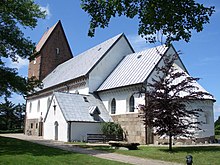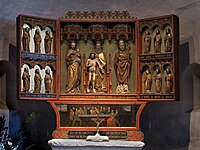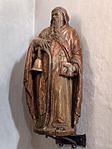St. Severin (Keitum)
The St. Severin Church is an Evangelical Lutheran church in Keitum on Sylt . It got its name after Severin von Köln , a bishop from the 4th century. The church stands apart from the village on the highest elevation of the Sylt Geest core . In pre-Christian times there was an Odin shrine at this point . The church was first mentioned in a document in 1240. Official investigations by the preservation authorities have shown that the roof structure of the church can be dated to the year 1216. It is therefore the oldest sacred building in Schleswig-Holstein.
construction
The nave, the much narrower choir and the semicircular apse are the oldest parts of the church. They come from the Romanesque period. The lower part of the masonry consists of granite blocks, above which Rhenish tuff and brick were used. Various friezes adorn the walls: stair friezes are located directly below the eaves of the nave and apse. A diamond lattice frieze joins the nave and a double round arch frieze at the apse. The apse is also divided by pilaster strips . The roofs of the old parts of the building are covered with lead .
The building materials and the basic structure can also be found in the smaller neighboring church of St. Martin in Morsum .
The late Gothic tower, built around 1450, stands out clearly from the older components with its red brick and tiled roof. It is the only brick Gothic architectural monument on Sylt. In ancient times it was also used as a place of refuge. Since it is visible from afar due to its exposed location, it used to serve as a landmark for seafarers . The tower was also used as a prison until 1806. After an accident in 1740, the interior was walled up and only reopened in 1981; it now serves as the entrance hall to the church.
A small, lead-covered vestibule is attached to the south side, which is called a calfaster (Latin calefacere = to warm up). It was probably originally used as a warm-up room. In 1979 it was converted into a sacristy.
inner space
The nave has two galleries , the west gallery from 1699 and the north gallery from 1724. The north gallery overlooks the northern lower rows of banks up to the central aisle, while the southern rows are free. The tower hall, nave and choir are flat-roofed, the apse has a semi-domed vault .
Furnishing
Baptismal font
The baptismal font is the oldest piece in the church. The time of origin is the 12./13. Century, the parish gives around the year 1000. It consists of Rhenish sandstone, probably from the Bentheim region. The cylindrical cup is decorated with tendrils. The square base shows four lions.
Winged altar
The three-part carved altar is located in the apse. It comes from the late Gothic period around 1480 - possibly from the school of the unknown Lübeck Imperialissima master . The mercy seat is depicted in the central shrine : God the Father presents the risen Christ to the community. The two side figures are Mary with the child and the bishop St. Severin. Sculptures of the twelve apostles can be seen in the side wings. The predella shows a baroque painting of the Last Supper from around 1705.
pulpit
The Renaissance pulpit from 1580 originally comes from Mögeltondern . It was donated to the church in 1699 by the pastor couple Gruppius. Corner pillars, relief figures and noble coats of arms were added to the pulpit. The figures represent Christian virtues: Fides (faith), Temperantia (moderation) and Iusticia (justice). The sound cover of the pulpit is six-sided. Head medallions can be seen in the gables.
Paintings and sculptures
- The ceiling was painted by Franz Korwan (1865–1942).
- On the north wall, besides the votive picture of the donors from 1654, there are two baroque paintings, the Descent from the Cross and the Entombment of Christ (17th century).
- The statue of John the Baptist is an Upper Rhine work from the 17th century.
- In the choir there is a wooden sculpture from the 15th century, which shows St. Anthony . She is believed to be of Spanish origin.
organ
The new organ replaces the previous instrument from 1787. It was built in 1999 by the Mühleisen company in Leonberg . With 46 sounding stops, it is the largest church organ in North Friesland.
|
|
|
|
|||||||||||||||||||||||||||||||||||||||||||||||||||||||||||||||||||||||||||||||||||||||||||||||||||||||||||||||||||||||||||||||||||||||||||||||||||||||||||||||
-
Pairing :
- Normal coupling: II / I, III / I, III / II, I / P, II / P, III / P
- Super octave coupling: III / P
- Sub-octave coupling: III / I, III / II, III / III
chandelier
The brass candlesticks were made in the Netherlands and donated by captains in 1683, 1698 and 1700.
Bells
The Keitum Church has three bells :
- The gis'-bell (700 kg) with the inscription: "I lament the dead, I admonish the living, God, I praise the Lord."
- The fis'-bell (841 kg); it bears the inscription "God, the Lord, is sun and shield" and the names of the bride and groom for whose wedding the bell was donated.
- The h 'bell (381 kg) with the year "AD 1966" and the name of the church mayor Jens Uhl.
restoration
The church will be renovated in autumn 2017 due to an infestation by the colorful poch beetle . The measure is supported by additional funds from the 2017 special monument protection program.
graveyard
Around the church is the St. Severin cemetery. The dead were buried here in pre-Christian times and Germanic gods were worshiped here. The stone well next to the apse of the church dates from this time. Presumably it was a cult stone dedicated to the goddess Freya . In Christian times until 1991 it served as a threshold stone in front of the north door of the church.
There are historical tombstones around the church. The oldest date from the 17th century. Some only bear the year of death and the initials of the deceased, while others are richly decorated and tell of the life and work of wealthy Keitum families, including seafarers and captains.
Several well-known personalities are buried in the cemetery, such as Rudolf Augstein (1923 - 2002), Peter Suhrkamp (1891 - 1959) and Gerhard Schröder (CDU) (1910 - 1989).
Contemporary works of art on the paths of the cemetery invite you to reflect: at the west entrance of the cemetery the statue "Totengedenken" by artist Ernest Igl from the 1980s, south of the church the bronze sculpture "Komtur" (a figure with a "cloak of conscience" as empty Cover) by the Bohemian artist Anna Chromy , at the northern end of the cemetery the figure "Boot" by the Hamburg sculptor Ludger Trautmann (born 1958) from 2006, on the north wall of the cemetery chapel the tile picture "Garden of Eden" by Dieter from 1968 Röttger , at the southeast entrance of the cemetery, the wooden sculpture "The Good Shepherd" by Ulrich Lindow (born 1949) from 2002.
literature
- Art topography Schleswig-Holstein . Wachholtz, Neumünster 1982, ISBN 3-529-02627-1 .
- DuMont art travel guide Schleswig-Holstein . DuMont, Cologne 1989, ISBN 3-7701-0936-8 .
- Information sheet about the church from the Evangelical Lutheran parish Keitum on Sylt.
Web links
Individual evidence
- ↑ St. Severin: The oldest church in the country. shz.de, accessed on January 13, 2016
- ^ Art-Topography Schleswig-Holstein . Wachholtz, Neumünster 1982, ISBN 3-529-02627-1
- ↑ Information sheet on the church from the Evangelical Lutheran parish Keitum on Sylt
- ↑ www.st-severin.de - History of the Church of Sankt Severin, accessed on January 13, 2016
- ↑ Hamburger Abendblatt March 9, 2017 Rescue for Schleswig-Holstein's landmark.
- ↑ Ev.-Luth. Keitum parish on Sylt: Friehof by the sea. Retrieved August 20, 2020 .
Coordinates: 54 ° 54 '7.2 " N , 8 ° 21' 49.6" E













